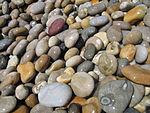I posted a story on the Chesil Beach a few years ago but now Gary has sent in a link to his web site that some readers may find interesting – go to www.godkingscenario.com/blog/chesil-beach-stones-mars … I suppose if you take Velikovsky literally when it comes to stones falling out of the sky one might visualise Chesil Beach in Dorset as one such place where they might have landed – but there are an enormous number of stones there. However, this is not to dismiss Gary's article as it has a lot of information about the stones he has gleaned from various sources. This is a follow up to his idea that sand on the earth, in part, has an origin on Mars. The stones are made of flint and chert which also has an origin in silica. That is the connection he wishes to make. I've walked along Chesil Bank on a number of occasions, been camping on the other side of the Fleet, a lagoon at the back of the beach, and generally been mystified by them. The bank is 18 miles in length and dominates the eastern end of the bay. Did they all fall out of the eroding cliffs?


Obviously, the tide is capable of smoothing and rounding the stones – and this can occur in a surprisingly short period of time. If the stones originated in the middle of the Holocene (from the cliffs that have been rapidly receding for at least 8000 years) could enough flints have gradually found their way onto the bank? A storm surge at some point in time appears likely. Whatever, Chesil Beach was probably formed during a catastrophe – but did the stones originate in another catastrophe?
Geologists search for uniformitarian explanations but the sheer scale of the pebble and shingle beach defies an ordinary answer – especially as the Jurassic cliffs have been eroding at a very rapid rate of knots. Gary includes information about the origin of flint and chert but you can find out a lot more simply by put flint into your search engine. Peculiar conditions, he says, are required for silica to from solution. That is why geologists are not agreed on the way flint has formed. Some flint actually has percolated down into cracks and faults and tends to form what is known as tabular bands. These are best seen at the Seven Sisters cliffs in Sussex. However, bands of tabular flint can also occur on other chalk faces – such as occur in the Thames Valley. Neolithic flint knappers sought out tabular flint as it could be quite thick and one large core could keep a flint tool specialist busy for weeks. See also http://discovery.ucl.ac.uk/1306709/1/1306709.pdf
